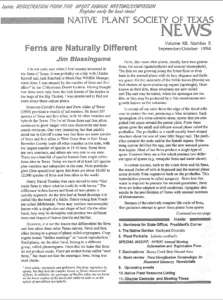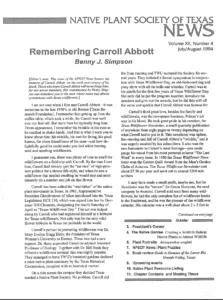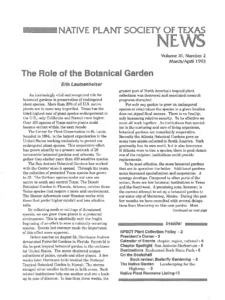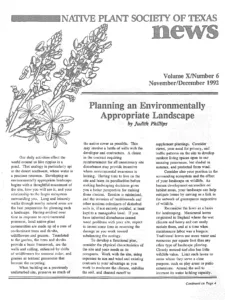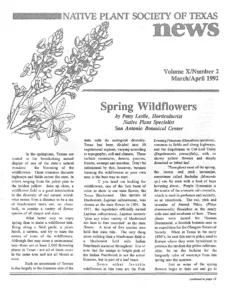Latest Issues

Fall 2025 Member Magazine
President’s Message | Executive Update | Celebrating Leadership | Curb Appeal with a Cause | Grant Recipients | Autumn’s Perfect Pairing | Native Plant Database | Sustainable Landscaping | Winterizing Tips

Summer 2025 Member Magazine
Executive Summary | Resilience in Bloom | Suburban Sanctuary | Texas-tough Summer Survivors | Where Salsa Meets Sage | A Rain Garden Grows | Member News | Smart Watering

Spring 2025 Member Magazine
Executive Summary | Blooming with Possibility | Wildflower Waltz | Native Grasses | Member News | Texas Wildflower Day
Distribution
- Texas Native Plants is published quarterly and the digital version is distributed free to all Society members in current standing.
- The digital version is also available in our library below.
- Print versions are mailed at no cost to Society members in current standing who select to receive a print copy when they join/renew.
- Libraries, educational institutions and other organizations may qualify to receive the publication for a $5 annual fee.
- Contact the membership coordinator.
- Many of our chapters publish their own newsletters and websites.
- These have their own deadlines and guidelines. See list of chapters.
History
Since its founding the Society has provided a news periodical to its members. there have been a variety of names and formats. The Texas Wildfower Newsletter edited by Carroll Abbott served as the first newsletter. He advocated the formation of the Native Plant Society of Texas in his quarterly publication Texas Wildflower Newsletter. After the Society was created in 1980, a free subscription to Abbott’s newsletter was provided as a benefit to all members. His declining health eventually prompted Abbott to request that the Society start its own newsletter. Lean more about the Carroll Abbott story.
Beginning in 1983 our own official publication has documented the evolution of the native plant movement and the Native Plant Society of Texas. The publication has had several slightly different names and formats over the years. By 2005 it had evolved into a full-color glossy magazine.
Editorial Submissions
The Native Plant Society of Texas encourages submission of articles, photos, pertinent news or other interesting information for publication.
- Submit articles or written items as email attachments.
- Send photos as email attachments in JPG, RAW or TIFF format.
- Larger file size and best quality are preferable.
- Contact the Editor for more information.
We reserve the right to edit all submissions for accuracy, relevance, length, grammar or for other reason. In matters of style our print publication generally follows the Chicago Manual of Style.
Unless prior arrangements with the editor are made, submissions may also appear on our website and linked on our social media pages. We do not accept outside advertising in any of our publications.
Publications Library
Click below to view issues by year/editor. Or visit our online archive.
1995 – Jan/Feb
- Native Ornamental Grasses
- Ground Rules for Building on Natural Land
- Gulf prairies & Marshes
- Hymenoxys scaposa
1994 – Nov/Dec
- Wildflowers of the Panhandle
- Native Flowering Herbs
- “Lost” Maples of the Hill Country
1994 – Sep/Oct
- Ferns are Naturally Different
- Reflections on Backyard Diversity
- Lobelia cardinalis
1994 – July/Aug
- Carroll Abbott Memorial
- Creating a Wildlife Habitat
- Anisacanthus wrightii
1994 – May/June
- Sedges for the Landscape
- Destination Corpus Christi
- Cyrilla racemiflora
1994 – Mar/Apr
- Spring West of the Pecos
- View From the Nursery: Interview w/ Terry Tate
1994 – Jan/Feb
- Lesson From My Garden – Jill Nokes
- Friedrich Wilderness Park
1993 – Nov/Dec
- Creating a Border…Texas Style
- Site Protection During Construction
1993 – Sep/Oct
- Bear Grass & the Yucca Moth
- Southline Equipment Company’s Native Garden
1993 – Jul/Aug
- Micropropagation of Native Plants
- Arbutus xalapensis (Texas Madrone)
- The Healing Power of Nature
1993 – May/June
- The Rolling Plains in Flower
- Coastal Region’s Plant Lists
- Palo Duro Floral Loop
1993 – Mar/Apr
- The Role of the Botanical Garden
- Landscaping for the Highway
1993 – Jan/Feb
- Annual Meeting News
- Texas Bamboo
1992 – Nov/Dec
- Planning an Environmentally Appropriate Landscape
- Celestial Symbols in Botanical Books
- Tips: Fall Landscape Maintenance
- Webworms & Wasps
1992 – Sep/Oct
- Leave It to Sumac for State’s Fall Color
- Successful Seed Collecting Tips for Natives
- Viewpoint: Biodiversity & Endangered Species Act
1992 – July/Aug
- What’s In a Name: Plant Taxonomy
- Caution: Oak Wilt Micro Injections
- Wildflowers In Your Landscape
1992 – May/June
- A Tale of Two Cypresses: Bald & Montezuma Cypress
- Long Term Rest Does Not Help Plant Diversity
- Nematodes
- Propagation Notes: Bald Cypress/Mesquite
1992 – Mar/Apr
- Spring Wildflowers
- Earthworms
- Propagation Notes: Dwarf Palmetto/Mexican Palm
1992 – Jan/Feb
- Amy Shelton McNutt Memorial
- Toward a Healthy Soil
- Propagation Notes: Pecan Tree/Wax Myrtle
1991 – Nov/Dec
- On the Trail of the Silky Camellia
- “Fallout” Habitat for Neotropical Migratory Birds
- Aquatic Plants: Helpful Hints
- Propagation Notes: Native Grasses




